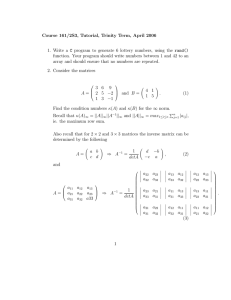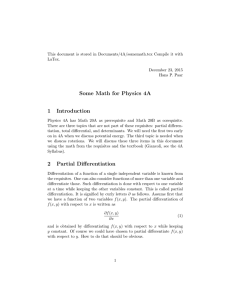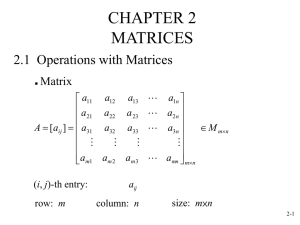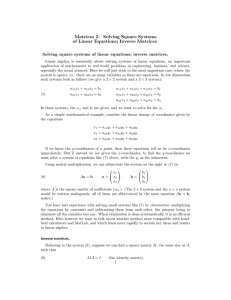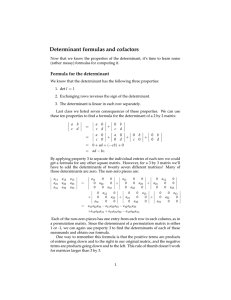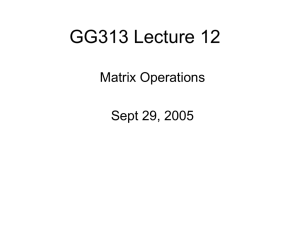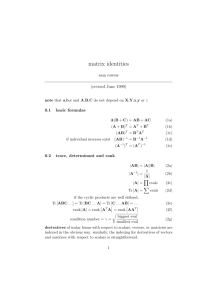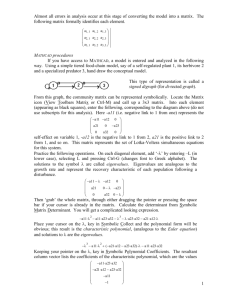Useful Matrix Formulas 1 1 Calculus
advertisement
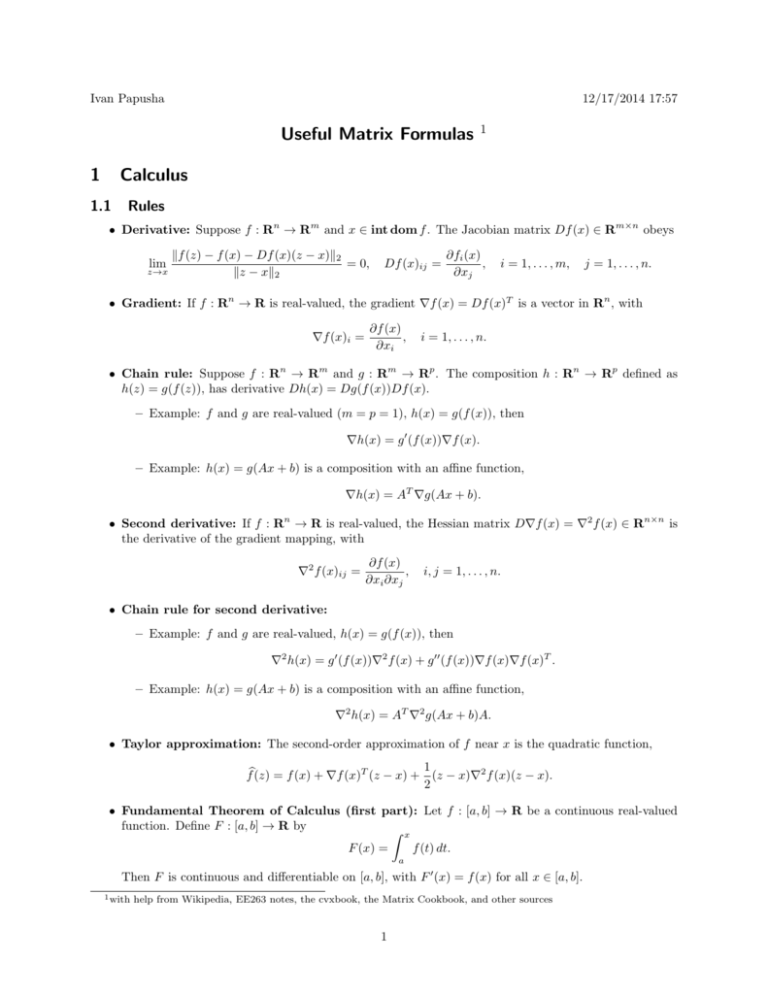
Ivan Papusha
12/17/2014 17:57
Useful Matrix Formulas
1
1
Calculus
1.1
Rules
• Derivative: Suppose f : Rn → Rm and x ∈ int dom f . The Jacobian matrix Df (x) ∈ Rm×n obeys
lim
z→x
kf (z) − f (x) − Df (x)(z − x)k2
= 0,
kz − xk2
Df (x)ij =
∂fi (x)
,
∂xj
i = 1, . . . , m,
j = 1, . . . , n.
• Gradient: If f : Rn → R is real-valued, the gradient ∇f (x) = Df (x)T is a vector in Rn , with
∇f (x)i =
∂f (x)
,
∂xi
i = 1, . . . , n.
• Chain rule: Suppose f : Rn → Rm and g : Rm → Rp . The composition h : Rn → Rp defined as
h(z) = g(f (z)), has derivative Dh(x) = Dg(f (x))Df (x).
– Example: f and g are real-valued (m = p = 1), h(x) = g(f (x)), then
∇h(x) = g ′ (f (x))∇f (x).
– Example: h(x) = g(Ax + b) is a composition with an affine function,
∇h(x) = AT ∇g(Ax + b).
• Second derivative: If f : Rn → R is real-valued, the Hessian matrix D∇f (x) = ∇2 f (x) ∈ Rn×n is
the derivative of the gradient mapping, with
∇2 f (x)ij =
∂f (x)
,
∂xi ∂xj
i, j = 1, . . . , n.
• Chain rule for second derivative:
– Example: f and g are real-valued, h(x) = g(f (x)), then
∇2 h(x) = g ′ (f (x))∇2 f (x) + g ′′ (f (x))∇f (x)∇f (x)T .
– Example: h(x) = g(Ax + b) is a composition with an affine function,
∇2 h(x) = AT ∇2 g(Ax + b)A.
• Taylor approximation: The second-order approximation of f near x is the quadratic function,
1
fb(z) = f (x) + ∇f (x)T (z − x) + (z − x)∇2 f (x)(z − x).
2
• Fundamental Theorem of Calculus (first part): Let f : [a, b] → R be a continuous real-valued
function. Define F : [a, b] → R by
Z x
f (t) dt.
F (x) =
a
Then F is continuous and differentiable on [a, b], with F ′ (x) = f (x) for all x ∈ [a, b].
1 with
help from Wikipedia, EE263 notes, the cvxbook, the Matrix Cookbook, and other sources
1
• Fundamental Theorem of Calculus (second part): Let f and g be functions such that for all
x ∈ [a, b], f (x) = g ′ (x). If f is Riemann integrable on [a, b], then
Z
b
a
f (x) dx = g(b) − g(a).
• Differentiation under the integral sign: Suppse we have
F (x) =
Z
b(x)
f (x, t) dt,
a(x)
then the derivative is
d
F (x) = f (x, b(x))b′ (x) − f (x, a(x))a′ (x) +
dx
1.2
Z
b(x)
a(x)
∂
f (x, t) dt.
∂x
Derivatives
• Linear functions:
∂xT a
∂aT x
=
=a
∂x
∂x
• Quadratic functions:
∂
(Ax + b)T W (Cx + d) = AT W (Cx + d) + C T W T (Ax + b)
∂x
∂
∂
(Ax + b)T W (Ax + b) =
kAx + bk2W = AT (W + W T )(Ax + b)
∂x
∂x
∂
kAx + bk22 = 2AT (Ax + b)
∂x
∂ T
x Ax = (A + AT )x
∂x
• Norms:
∂
x+b
kx + bk2 =
∂x
kx + bk2
1.3
Inverses
• Inverse of a 2 × 2 matrix:
a11
a21
a12
a22
−1
=
1
a22
det(A) −a21
−a12
a11
where det(A) = a11 a22 − a12 a21
• Inverse of
a11
a21
a31
a 3 × 3 matrix:
−1
a12 a13
−a23 a32 + a22 a33
1
a23 a31 − a21 a33
a22 a23 =
det(A)
a32 a33
−a22 a31 + a21 a32
a13 a32 − a12 a33
−a13 a31 + a11 a33
a12 a31 − a11 a32
−a13 a22 + a12 a23
a13 a21 − a11 a23
−a12 a21 + a11 a22
where det(A) = a13 (−a22 a31 + a21 a32 ) + a12 (a23 a31 − a21 a33 ) + a11 (−a23 a32 + a22 a33 )
2
2
Least squares and SVD
2.1
Singular value decomposition
• Mappings: Every matrix A ∈ Rm×n maps the unit ball in Rn to an ellipsoid in Rm , i.e, if
S = {x ∈ Rn : kxk ≤ 1} 7→ AS = {Ax : x ∈ S}
by the set {x ∈ Rn : xT B −1 x ≤ 1}, where the
An ellipsoid induced by the matrix B ∈ Sn++ is given
√
semi-axis lengths are square roots of eigenvalues λi and semi-axis directions are unit eigenvectors vi
of B.
Rn
√
λ2 v 2
√
λ1 v 1
Pr
• SVD: A = U ΣV T = i=1 σi ui viT , where r = Rank(A). Equivalent to Avi = σi ui , where u1 , . . . un
are the left singular vectors, v1 , . . . , vn are the right singular vectors, and σ1 ≥ · · · ≥ σn ≥ 0 are the
singular values of A.
Rn
v1
Rm
v2
σ2 u2
σ1 u1
x 7→ Ax
• Computing the SVD:
σi =
q
λi (AT A) or
q
λi (AAT )
ui = eigenvectors of AAT
vi = eigenvectors of AT A
• Range and null space: If r = Rank(A), then
{u1 , . . . , ur } is an orthonormal basis for R(A).
{vr+1 , . . . , vn } is an orthonormal basis for N (A).
• Testing for membership in span: ydes ∈ R(A),Pif Rank [ydes A] = Rank(A). Also if A = U ΣV T
r
is the SVD then the component of ydes in R(A) is i=1 ui uTi ydes , meaning
!
r
X
T
T
ui ui ydes = (I − Û Û )ydes = 0.
ydes ∈ R(A) ⇔ z = ydes −
i=1
3
2.2
Linear problems
• Pseudoinverse: Suppose A ∈ Rm×n with (thin) singular value decomposition A = Û Σ̂V̂ T The
Moore-Penrose inverse A† is given by A† = V̂ Σ̂−1 Û T . Furthermore, if A is full rank,
A† = lim (AT A + µI)−1 AT
µ→0
= lim AT (AAT + ǫI)−1
ǫ→0
(
(AT A)−1 AT if A is skinny, A† is a left inverse
=
AT (AAT )−1 if A is fat, A† is a right inverse
• Least squares (estimation):
N (A) = {0})
A is skinny and full rank (m > n, more equations than unknowns,
xopt = arg minn kAx − yk = A† y = (AT A)−1 AT y
x∈R
• Minimum norm (control):
R(A) = Rm )
A is fat and full rank (m < n, more control inputs than outputs,
xopt = arg
min
x∈Rn ,Ax=y
• Canonical multiobjective least squares:
where
kxk = A† y = AT (AAT )−1 y
Wish to minimize competing objectives J = J1 + µJ2 ,
J1 = kAx − yk2 ,
J2 = kxk2 .
Solution given by xopt = (AT A + µI)−1 AT y.
• General multiobjective least squares:
where
Wish to minimize competing objectives J = J1 + µJ2 ,
J1 = kAx − yk2
J2 = kF x − gk2
J1 + µJ2 = kAx − yk2 + µkF x − gk2
2
A
y .
√
√
=
x
−
µF
µg Solution given by xopt = (AT A + µF T F )−1 (AT y + µF T g).
• Positive semidefinite cone:
a symmetric matrix is positive semidefinite if and only if all its
principal minors (determinants of symmetric submatrices) are nonnegative, e.g.,
x1 x2 x3
x1 ≥ 0, x4 ≥ 0, x6 ≥ 0,
x2 x4 x5 0 ⇐⇒
x1 x4 − x22 ≥ 0, x4 x6 − x25 ≥ 0, x1 x6 − x23 ≥ 0
x1 x4 x6 + 2x2 x3 x5 − x1 x25 − x6 x22 − x4 x23 ≥ 0
x3 x5 x6
4
3
Matrix gymnastics
3.1
Block formulas
• Completion of squares: A ∈ Sn++ , D ∈ Sm , B ∈ Rn×m ; a, b, x, y ∈ R with a 6= 0 :
2 b2
b
2
2
y2
ax + 2bxy + dy = a x + y + d −
a
a
T A B x
x
= xT Ax + 2y T B T x + y T Dy
BT D y
y
= (x + A−1 By)T A(x + A−1 By) + y T (D − B T A−1 B)y
which gives general formula for minimization problem:
T A B x
x
= y T (D − B T A−1 B)y,
min
BT D y
y
x
xopt = arg min(·) = −A−1 By
x
• Block LDU decomposition: since above holds for all x, y
0
I
0 A
A B
I
=
B T A−1 I 0 D − B T A−1 B 0
BT D
• Asymmetric block LDU decomposition:
I
0
I
0 A
A B
=
CA−1 I 0 D − CA−1 B 0
C D
A−1 B
I
A−1 B
I
• Block matrix inverse: invert using LDU decomposition (or complete square to minimize over y)
−1 −1
A + A−1 BS −1 CA−1 −A−1 BS −1
A B
=
C D
−S −1 CA−1
S −1
T −1
−T −1 BD−1
,
=
−D−1 CT −1 D−1 + D−1 CT −1 BD−1
S = D − CA−1 B (Schur complement)
T = A − BD−1 C
• Schur complement: If the Schur complement of a block matrix is S = D − CA−1 B, then
A B
det
= det A det S
C D
• Matrix inversion lemma: equating block inverses,
(A − BD−1 C)−1 = A−1 + A−1 B(D − CA−1 B)−1 CA−1 .
• Rank-one update: special case of the matrix inversion lemma, B = u, D = −1, C = v T ,
(A + uv T )−1 = A−1 −
A−1 uv T A−1
.
1 + v T A−1 u
• Matrix determinant lemma: special case with matrix whose Schur complement is 1 + v T A−1 u,
det(A + uv T ) = (1 + v T A−1 u) det(A).
• More gymnastics:
A(I + A)−1 = I − (I + A)−1
(I + AB)−1 = I − A(I + BA)−1 B
A(I + BA)−1 = (I + AB)−1 A (push-through)
5
3.2
Schur complements
n
X ∈ S and its Schur complement are partitioned as
A B
, S = C − B T A−1 B.
X=
BT C
• X ≻ 0 if and only if A ≻ 0 and S ≻ 0.
• If A ≻ 0, then X 0 if and only if S 0.
In addition, since the condition Bv ∈ R(A) is the same as (I − AA† )Bv = 0,
• X 0 if and only if A 0, B T (I − AA† ) = 0, and C − B T A† B 0.
• X 0 if and only if A 0, (I − AA† )B = 0, and C − B T A† B 0.
3.3
S-procedure
Let fi (x) = xT Pi x + 2qiT x + ri be quadratic functions of variable x ∈ Rn with Pi = PiT for all i = 1, . . . , p.
• Nonstrict inequalities: if there exist scalars τ1 ≥ 0, . . . , τp ≥ 0 such that for all x,
f0 (x) −
p
X
i=1
τi fi (x) ≥ 0,
then
f0 (x) ≥ 0 for all x such that fi (x) ≥ 0,
i = 1, . . . , p.
In addition, the converse holds
– if the functions fi are affine (Farkas lemma), or
– if p = 1 and there is some x0 such that f1 (x0 ) > 0.
• Strict inequalities: if there exist scalars τ1 ≥ 0, . . . , τp ≥ 0 such that
P0 −
p
X
i=1
τi Pi ≻ 0,
then
xT P0 x > 0 for all x 6= 0 such that xT Pi x ≥ 0,
In addition, the converse holds
– if p = 1 and there is some x0 such that xT0 P1 x0 > 0.
6
i = 1, . . . , p.
4
Convex optimization
4.1
KKT conditions
The primal problem is
minimize
subject to
f0 (x)
fi (x) ≤ 0,
hi (x) = 0,
i = 1, . . . , m
i = 1, . . . , p,
where fi : Rn → R are convex for all i = 0, . . . , m and hi : Rn → R are affine for all i = 1, . . . , p.
⋆
• Stationarity: ∇f0 (x ) +
m
X
i=1
λ⋆i ∇fi (x⋆ )
+
p
X
i=1
νi⋆ ∇hi (x⋆ ) = 0
• Primal feasibility: fi (x⋆ ) ≤ 0 for all i = 1, . . . , m, and hi (x⋆ ) = 0 for all i = 1, . . . , p
• Dual feasibility: λ⋆i ≥ 0 for all i = 1, . . . , m
• Complementary slackness: λ⋆i fi (x⋆ ) = 0 for all i = 1, . . . , m
4.2
General vector composition rule
Define the composition
f (x) = h(g1 (x), g2 (x), . . . , gk (x)),
k
where h : R → R is convex, and gi : Rn → R. Suppose that for each i, one of the following holds:
• h is nondecreasing in the ith argument, and gi is convex
• h is nonincreasing in the ith argument, and gi is concave
• gi is affine
Then the function f is convex.
4.3
Duality
The domain of the primal problem is D =
m
Tm
i=0
dom fi ∩
p
Tp
i=1
dom hi
• Lagrangian: has dom L = D × R × R and is given by
L(x, λ, ν) = f0 (x) +
m
X
λi fi (x) +
i=1
p
X
νi hi (x)
i=1
• Dual function: g(λ, ν) = inf x∈D L(x, λ, ν). The dual optimization problem is
maximize
subject to
g(λ, ν)
λ 0.
• Slater’s condition: Suppose the primal problem is convex and the first k inequality functions
f1 , . . . , fk are affine. Then strong duality holds if there exists an x ∈ relint D with
fi (x) ≤ 0,
i = 1, . . . , k,
fi (x) < 0,
i = k + 1, . . . , m,
hi (x) = 0,
i = 1, . . . , p.
Here, we define the relative interior and the affine hull of a set C as
relint C = {x ∈ C | B(x, r) ∩ aff C ⊆ C for some r > 0}
aff C = {θ1 x1 + · · · + θk xk | x1 , . . . , xk ∈ C, θ1 + · · · + θk = 1}
7


